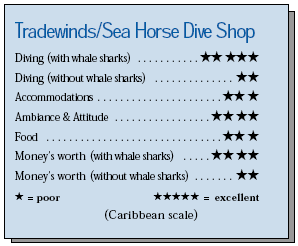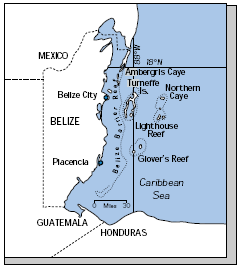Behemoths in BelizeContents of this Issue: Cruising Vanuatu aboard the Nai'a The President and the Lady ó Together Again! EQUIPMENT TIP: BLACK LIGHT DIVING Belize Coral: End of a Millennium Independent Journalism on Bonaire Is Sipadan the Shape of Things to Come? Editorial Office: Ben Davison Publisher and Editor Undercurrent 3020 Bridgeway, Suite 102 Sausalito, CA 94965 scheduled whale shark trips in Placencia from the June, 2000 issue of Undercurrent
If divers kept life lists like birders do, a whale shark would be near the top, up there with rarities like ivory-billed woodpeckers and quetzals. Every diver I know whoís seen one has a story to tell, but usually theyíre chance sightings -- it was just his lucky day. As far as I know, Sea Horse Dive Shop in Placencia, Belize, is the only dive operation in the Americas -- and one of the few in the world -- to offer a regular program of planned whale shark dives, as opposed to snorkeling or chance dive encounters. Though Placenciaís an interesting -- albeit slightly funky -- village, it wouldnít ordinarily be high on my list of diving destinations. But the chance to dive with whale sharks makes it special. At lengths up to 55', whale sharks are the worldís largest fish and are sharks,
not whales. Their immense, gaping mouths are adapted for filtering plankton and
small bait fish through specially adapted gills. These white-spotted behemoths migrate three times a year, in the fall, winter, and spring. Fall and winter they
are following spawning tuna, and itís strictly snorkel action. The May/April migration
is for the cubera snapper spawn, and these fish hang deep, so the action
is on scuba. You might wait the whole trip for the moment when a whale shark
slowly materializes, but when that moment
comes, itís unforgettable. The prop flight in from Belize City provides a good view of the 16 miles of thin Placencia peninsula that ends in the village of Placencia, population about 1000. The small Tropic Air shack on the dirt airstrip serves as cell-phone control tower, business office, baggage claim, waiting room, and cold drink stand. They called me a taxi, which arrived in a swirling red cloud from the dusty, unpaved road. A short, inexpensive, and kidney-stimulating drive and I was in the village center, with polite islanders going cheerfully about their daily routine. Once you initiate contact, the only attitude here is good. I stayed in one of five small cottages at the Tradewinds, less than 10 yards from a calm, picture-perfect, semicircular bay. Situated on a point, with a collapsing pier in front, it was blissfully quiet, the night stillness broken only by rustling palm fronds and the occasional smack of a falling coconut or mango. The large-grained sand beach had potential, but was badly in need of the litter and rake patrol. The cottage had excellent screening, although if the louvers were open, passersby could peer in. (Somehow in sleepy Placencia, it doesnít seem to matter.) The digs sported a fan The entire area was mercifully sparse, though not without mosquitoes and no-see-ums., medium-sized fridge, coffeemaker, and several unshaded bulbs on the ceiling, but no phone or TV. The small bathroom had a vigorous toilet and plenty of hot water, and well-worn but fresh towels and sheets arrived daily. The experience was altogether tropical and profoundly relaxing -- all for the very comfortable price of $US55/night high season/holidays (less at other times). Itís a modest walk to several other reasonably priced, basic hostels, such as Westwind and South Water, which range from $35 to $80 a night, depending on the season and unit. Many of these mid-priced hotels lack a/c, but most have fans. I looked at the Westwind, which was much like the Tradewinds but not quite as decent. Rum Point Inn and Kittyís Place are more upscale, but farther out of town. Kittyís had six rooms, three cabanas, and two apartments. I checkout out the cabanas, which didnít seem as nice as the Tradewinds cottages, but they were slightly less expensive, which probably accounts for their popularity with backpackers. Rum Point is a 10-acre property with bar and restaurant and 10 cabanas on the bay, plus a dozen suites set further back, as well as a pool and a/c, both rarities in Placencia. Its dive op has a comfortable Pro 42, and they also offer interesting side trips to ruins and rivers. Of course, itís also more expensive, running about $125-145 a night in high season. There is no restaurant or bar at the Tradewinds, but the one concrete sidewalk
on the sand winds its way through the tiny town, past several eateries. I liked
Omarís tiny spot for a full breakfast and the fresh tortillas with homemade guava jelly. Whale shark dives are the province of Sea Horse Dive Shop, which was only about three blocks away from the Tradewinds. Thatís not far to walk, but somehow it seems further when your gear is piled in the Tradewindsí lone wheelbarrow and youíre marching along behind like Farmer McGregor, pushing it down the street. I only treated Placencia to that sight once, though. After that first morning I rinsed my gear each evening, Sea Horse stowed it securely at the shop overnight, and rigs were always on board when I arrived the next morning. Sea Horse is owned and operated by Brian Young, a Placencia native, with the able help of his wife Ardie, sister-in-law Julie, brother-in-law Louis, and a plethora of agreeable, young assistants. Brian has been instrumental in promoting diving and conservation in Placencia and is currently active in World Wildlife Fund efforts to make the Elbow and Silk Cays area, where the whale sharks migrate, protected marine reserve. He fished and dived the area for years before opening the shop about five years ago. Now heís diligently charting whale shark sightings, marking locations with GPS. Itís hard to imagine a more pleasant, laid-back op. Boats left when everyone arrived, often not until 9:30 or so, but no one hurried and no one worried. Briefings were good, and generally, divers were given lots of freedom on the 40-minute to one-hour dives. Brian runs three boats: a 33' with twin 150 Yamahas that carries 14 divers, a 25' with a single 115 Evinrude that carries 4 to 6 divers, and a 19' skiff powered by an 85 Yamaha that takes 2 to 4 divers. All are short on space when filled, and during my visit the larger two were always nearly full of U.S., Guatemalan, and European guests. Half the days both boats went to the same site, and half the days they went to different ones. The main boat has O2 and a first-aid kit; communication is by cell phone. Exits/entries are anywhere and anyway you can manage them; railings on the two larger boats make them challenging. Boats had portable rung ladders, but the ladder on the second boat was one rung too short, which caused a good bit of grumbling. The most entertaining of our group of five experienced divers was Pepito, an instructor from Guatemala City, who was all of 5í4" and feisty as a bull shark. When not eating, sleeping, or diving (which left precious little time), he would often remark quite seriously, ďyou know, Iím going to have to beat youíí to the head shrinker in our group, who was a 6í1", 235 lb. weight lifter. Pepito brought Matzo with him to make his parents happy but had no real clue when Passover was, so we ate them with our rum and cokes before going out to dinner, sometimes with such distinctly un-Kosher morsels as tinned mussels. We usually held our surface intervals on board. Snorkeling was possible, but due to depth and viz I couldnít see much. Lunch also was usually on board, but sometimes on Silk or Tobacco Cay, where thereís a small restaurant. Ardie worked up a toothsome baked red snapper to send along, and accompanied it with either rice or beans, occasionally salad, and water and thin fruit juice. Itís not much variety, but I didnít go away hungry. The whale shark drill is 2 dives a day: a morning dive around 11:00, finning as deep as 90' or so, looking for the schools of cubera snapper. If spotted, the dive group is to congregate tightly above, creating a large column of bubbles that hopefully will attract the curious whale shark, who may think itís a chimney of spawn. I found this a low-yield dive as spawning typically doesnít take place until later in the day, though sightings sometimes occur. The afternoon dive starts around 3:00 and seems more likely to deliver. (Take a hint from when the whale shark research vessel starts diving, which usually isnít till late afternoon.) Areas of spawn can clearly be seen by around 5:30, but the crew doesnít like diving this late since you wonít get back to shore until well after dark. Nevertheless, insist on diving as late in the day as possible. Brian often snorkeled, sometimes for half an hour, looking for the snapper. When he found them, we got in. When he didnít find them, well, we got in anyway, but Iím not sure why. If you fail to see the spawn fish, youíll most certainly fail to see Mr. Big. Ah, but what an inexpressible thrill when these docile plankton-eaters do appear, silent, graceful, and colossal. Their magnificence makes it difficult not to strike out to cruise alongside or reach out for a touch. But I learned to restrain myself, as such behavior only drove them away. If you do attempt to follow one, Brian will grab you; if you touch, youíre back on the boat. I observed him restrain a photographer by the arm and another diver by the fin when they bolted for one. And this is as it should be. On my last dive of the trip, we didnít go in until after 5 p.m. The minute we hit the water, four bottlenose dolphins, including a juvenile, came to play at close quarters. They were stunning with the late afternoon sun reflecting off their unblemished silver-gray skin as they shot about like a squadron of air-show jets. Soon, however, a 25' whale shark languidly cruised overhead, dwarfing the footprint of the dive boat floating above. Three more appeared during the dive. The days we didnít go for whale sharks, I found the dives largely disappointing. There werenít a lot of fish, and reefs were hardly pretty. The Shark Hole dive, at a premium price of $100/two-tank day, was mildly interesting (though not interesting enough to keep me from feeling slightly resentful about the premium charged). At 40', a section of a large collapsed cave dome appeared in the sandy bottom. As I dropped through the 10' opening, a pure sand bottom loomed about 110' below, photogenically scattered with cushion stars. The roof had a couple of decent-size stalactites, but not much else. Some king-size nurse sharks were hanging out here, but they bolted for the black depths as soon as I penetrated their domain. While watching other divers rise out of the opening into the sunlight, I noticed a small shark begin to enter, but it soon did a comic double take and was gone like a shot. On Second Cut, a wall dive you can take quite deep, a squadron of 8 spotted eagle rays came in at close range. The other dive worth remembering, MoHo Reef, was only memorable because it was utterly dead -- it looked like ground zero for a thermonuclear device. I did not see so much as a single living polyp of coral, and, if touched, what obviously was once a lush reef tumbled down in a melancholy heap. The abundant clusters of blue bell tunicates, which have an affinity for dead reef, appeared all the more vibrant against this background of devastation. Sea Horse should be ashamed to take anyone to MoHo Reef. In five days of diving, I saw whale sharks two days. Thatís consistent with Brianís estimate that one will see them 8-10 days a month during the spring migration. If thatís accurate, then chances are youíll make at least one encounter if you go for a week at prime time. For me, a couple of fruitful dives made this trip worthwhile. But, had Lady Luck been elsewhere, I would have found the diving profoundly unsatisfying. (The northern Belizean atolls are far superior.) The hour-plus rides to the sites are tiring in themselves, and vigorously finning through featureless open water in modest viz in search of these behemoths can be mind-numbing and bone-deep fatiguing. But when Lady Luck does strike, you wouldnít want to be doing anything else. Swimming with a whale shark is one remarkable experience, and it will go right to the top of your lifetime list, no doubt about it. óX.D. |

I want to get all the stories! Tell me how I can become an Undercurrent Online Member and get online access to all the articles of Undercurrent as well as thousands of first hand reports on dive operations world-wide
| Home | Online Members Area | My Account |
Login
|
Join
|
| Travel Index |
Dive Resort & Liveaboard Reviews
|
Featured Reports
|
Recent
Issues
|
Back Issues
|
|
Dive Gear
Index
|
Health/Safety Index
|
Environment & Misc.
Index
|
Seasonal Planner
|
Blogs
|
Free Articles
|
Book Picks
|
News
|
|
Special Offers
|
RSS
|
FAQ
|
About Us
|
Contact Us
|
Links
|
3020 Bridgeway, Ste 102, Sausalito, Ca 94965
All rights reserved.

 For me the most
breathtaking moment was when a 30-footer
rose slowly from the depths, passing 15'
below my fin tips, its mouth open until it
closed to swallow the catch.
For me the most
breathtaking moment was when a 30-footer
rose slowly from the depths, passing 15'
below my fin tips, its mouth open until it
closed to swallow the catch. For dinner, I found that the Galley grilled a mean
pork chop, thick and juicy, and offered frozen shrimp
with butter and garlic, curry, or Creole sauce. The
shrimp dishes were the most expensive on the menu, about
US$12. The Kowloon/Flamboyant prepared good Chinese
dishes, including chicken chow mein, and wok beef with
gravy & onions on rice. The most expensive dish on the
menu was about $US8. The Pickled Parrot served a decent
pizza and turned out to be the spot for drinking and
socializing. They had a wild party with a band while I
was there -- at 1 a.m. the place reeked of sweat and
coconut oil.
For dinner, I found that the Galley grilled a mean
pork chop, thick and juicy, and offered frozen shrimp
with butter and garlic, curry, or Creole sauce. The
shrimp dishes were the most expensive on the menu, about
US$12. The Kowloon/Flamboyant prepared good Chinese
dishes, including chicken chow mein, and wok beef with
gravy & onions on rice. The most expensive dish on the
menu was about $US8. The Pickled Parrot served a decent
pizza and turned out to be the spot for drinking and
socializing. They had a wild party with a band while I
was there -- at 1 a.m. the place reeked of sweat and
coconut oil. Diverís Compass: Sea Horse Dive Shop: 800-991-1969; phone/fax
011-501-6-23166; e-mail
Diverís Compass: Sea Horse Dive Shop: 800-991-1969; phone/fax
011-501-6-23166; e-mail 